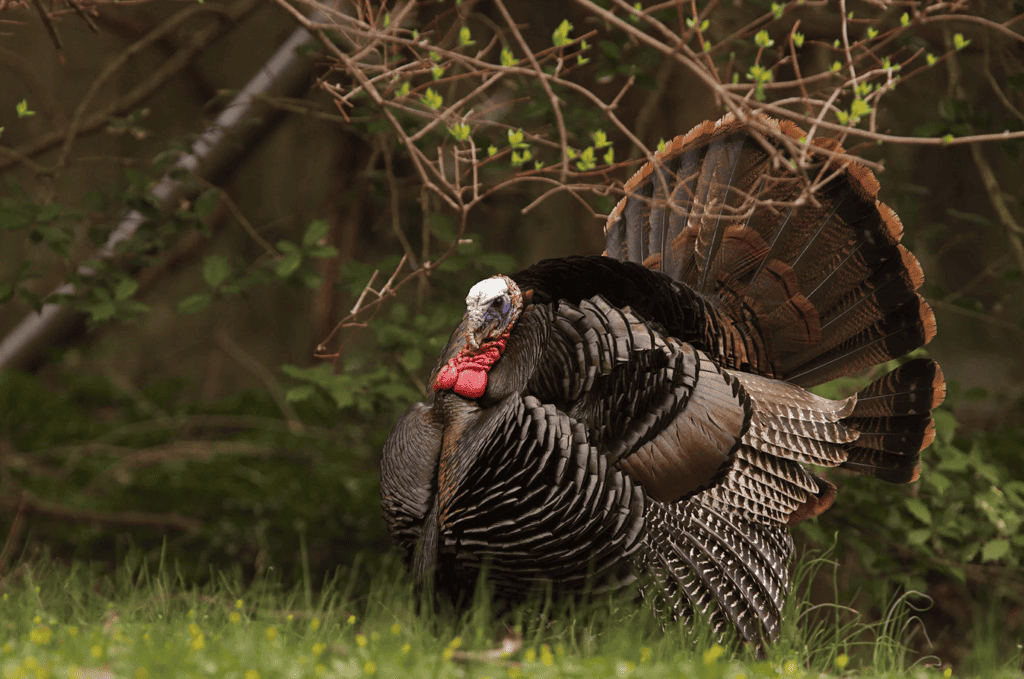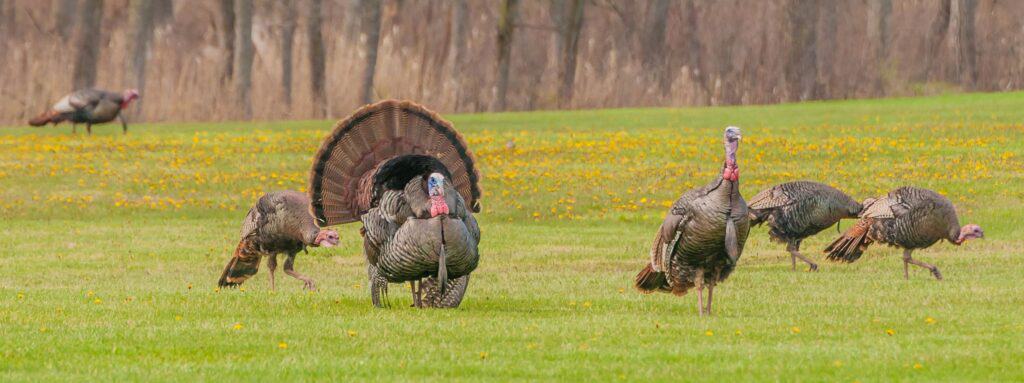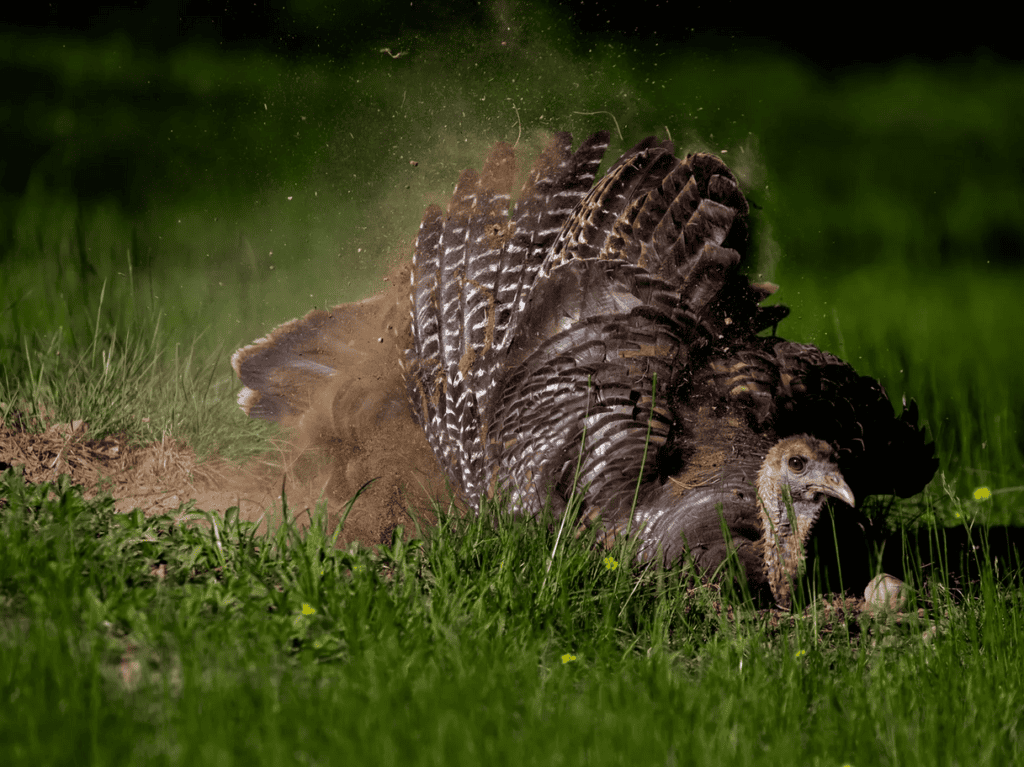With turkey season fast approaching, many of us are switching gears from deer and ducks to refocus our attention on longbeards. Some hunters have more time to spend in the woods than others, and you may be trying to figure out how to maximize your limited time during turkey season.
Turkeys are the most active and vocal early in the morning. Weather impacts activity throughout the season. Gobblers are regularly found free from hens later in the season during the middle of the day. Late in the evening turkeys are headed back to their roosting site and can be patterned.
Weather conditions, paired with the phase of the breeding season that turkeys are in, can have a great impact on when turkeys are most active on a given day. However, there are a couple of periods in the day when birds are more consistently active than others. Typically, early morning from the roost to their first feeding location is when most turkeys will be moving around.

Birds on the Roost
A roost tree is where turkeys stay at night and it’s where they are often very active at first light. When you sneak into the woods in the dark and get set up, birds are very willing to respond before pitching down and hitting the ground. Turkeys use roosts for protection from predators while resting at night. In the morning when they can see better, they pitch down to feed and hens go to check their nests.
The gobbling that takes place on the roost serves a few purposes. Toms gobble to communicate with hens and to figure out where other nearby birds may be. Gobbling is a way of letting every bird know that the tom is up, he’s surveying the area, and he’s ready to hit the ground. It is likely that at some point you will encounter a bird that is super talkative in a tree but stops gobbling after leaving the roost.
If a bird goes silent after he pitches down, he may be with a hen or feel confident he knows where one is. These are tough birds to kill if you don’t know where they are headed to feed.
But, a tom may still be vocal if he hasn’t found a receptive hen or is on his way to feed.
Turkeys are consistently the most active in the morning because they need to relocate hens and communicate with other birds. This is true during both the early and late seasons. Even if a bird shuts up after flying down, roost gobbling gives you a chance to locate them at the start of each day.
Ideal Weather Conditions
While there are obvious weather conditions that turkeys favor when it comes to being vocal, they are active in all types of weather conditions. If you are someone who loves to chase a gobble and pursue vocal turkeys, days with blue skies and calm winds are going to be your cup of tea. However, rainy or overcast days offer plenty of opportunities to catch birds feeding with their guard down.

Calm, Clear Days
Without much wind or rain, it is a lot easier for turkeys to communicate. Sound will carry farther, and toms are more likely to hear a hen clucking and putting. They also know their own gobble will carry farther distances and seem to be more willing to talk on these clear weather days.
One boosted advantage that turkeys have on clear days that hurts us as hunters is their eyesight. Their ability to see will be at its strongest. Birds will be on high alert and any out of place sound or movement can send them running.
On calm, clear days, expect to find turkeys spending the middle of the day feeding and resting in the timber. It gives shade in the hot parts of the season and provides a little more security. Turkeys will most likely be feeding in a green field in the early morning hours and the last few hours of light in the evening.
Overcast and Rainy Days
Turkeys are not as likely to be vocal on days with a lot of wind or rain. Their hearing is hindered and their own gobbles aren’t going to carry very far. However, they are more likely to spend extra time feeding in fields, and they will be more vulnerable when they can’t see or hear as well.
When it rains, worms, bugs, and insects that turkeys like to eat come above ground and are more active. This diversifies their menu and it keeps them in a field for more hours of the day.
Turkeys will also spend less time flying or pitching across valleys and ridges on rainy days because their feathers don’t get a chance to dry out. They are more likely to spend their time in a confined area or within walking distance of their roost tree.
Did You Know I Had a Newsletter?! 📬
I do! I send out a weekly email that talks all about deer hunting and is a bit more personal than a regular article. If you sign up right now, I will even send you the first chapter of my Ebook “The Hunters Guide to Scent Control” for free! What is there to lose? 🙂
Turkey Activity During Midday
Depending on the time of the season, the middle of the day can offer great opportunities to harvest a lonely gobbler. As the season runs on, it’s likely that hens will be making their way back to their nests in the middle of the day. Toms can find themselves without a hen and become more vocal and active as they try to locate another one.
If the birds are staying grouped up, expect them to be hanging in the timber, especially on hot spring days. The timber offers shade. Aside from staying cool, turkeys will also be looking for areas where they can loaf around and dust themselves off.
Dusting Sites
Turkeys create dusting sites by scratching at loose, dry soil to create a powder they can use as a dirt bath. They do this to get parasites, bugs, and moisture off of their feathers. If their feathers stay wet for too long they can get matted and make it difficult for birds to fly.
Don’t underestimate dusting sites as a spot to catch turkeys on a regular basis. The edge of a food plot, a four-wheeler or logging road, and underneath large evergreens that shade out vegetation are a few areas they will use to dust. These are all areas where turkeys can find ground that is suitable.

Turkey Activity in the Evening
Some aspects of turkey activity are at their height in the evening, like their actual physical movement. Others, like gobbling, tend to be much more subdued leading up to dusk. Turkeys aren’t as willing to draw attention to themselves as they are moving toward their roost tree.
Turkeys are much more willing to call when in the roost tree and right after flying down. It makes a lot of sense. Once they are in a tree they have a bird’s eye view of any danger below them. They lose that capability on the ground. Turkeys have all night and morning to be aware of any danger nearby, and if they don’t pick up on any, then let the gobbles roll. Evening requires more caution.
The birds are on the move in the evening, this is one thing that works to a hunter’s advantage. Turkeys will often stop by a green food source on their way to roost for the night. If you know where the birds in your area like to feed and roost at night, this can be a great time to catch them in between the two.
Early Season vs Late Season
Turkey season dates vary from state to state. When you’re trying to predict when turkeys will be the most active, it isn’t as simple as just looking at dates on a calendar. Hens nesting and being involved in the incubation period will have a big impact on spring turkey activity. The weather determines how early or late in the season this happens. A late spring means hens will nest later.
Early Season
In most states across the country, the beginning of the season will occur before many hens are receptive to breeding. Unpressured toms start the year off very willing to return your calls while they search and wait for the first few receptive hens.
As spring goes on the majority of the females in the flock start to accept suitors. Fewer toms will be willing to gobble back at you. Toms will not be willing to break off on their own and search for another hen if they are already tending to one.
Late Season
Again, “late” season will vary from state to state. For the sake of this article, let’s say that the late season is after the majority of hens have started the nesting and incubation stage of the reproduction cycle.
When a hen is on a nest she won’t be entertaining a tom that is looking for love. Even if the birds have been pressured for a few weeks, a tom will likely still be willing to respond to calls as hens start to nest during the day. There aren’t as many options and they need to stay vocal and on the move if they want to find interested hens elsewhere.
Keep in mind, another advantage to mind during the late season is the added greenery in a forest. More foliage can make it easier to move on a bird that is hung up and not consistently responding to you. There tends to be less pressure in the woods these last few weeks of the season as well. There are fewer turkeys in the woods, but a lot of mature toms remain, and they may be getting desperate.
Wrap Up
If you are trying to determine when to commit your time to chase active turkeys this spring, keep a few things in mind. For consistent action, expect to hear the most gobbles first thing in the morning. But, don’t lose hope if your day isn’t successful right off the bat. Nesting hens, evening food sources, and even dusting sites can cause birds to be more active and increase the odds you find one in your sights.
Even the late season holds great opportunities when you use the right strategy for lonely gobblers. Spring turkey is a fun time of year. Enjoy the woods and the sounds of spring as you chase one of the more exciting game birds in America.
Sister Post | How To Find A Turkey Roost
A sister post is another post that I have written that follows along with the same topic as the one you just read. After reading this article, you will probably like this next one even more! Here is a little teaser…
While turkeys can be successfully hunted at any time during the day, the most popular time to hunt them is at the crack of dawn and in states where it is legal, just before dusk. The best way to successfully hunt these times…Keep Reading
The Perfect Roost
Like all animals, turkeys need food, water, and shelter. When searching for a roost location, keep an eye on areas that provide these three things…Keep Reading
Best Locations
As far as exact location, a turkey will prefer to roost…Keep Reading
Thank you for reading my article! I hope you enjoyed it, and if you have any questions or feedback, please send me an email at [email protected]. If you want to learn more about me or Omega Outdoors, visit my About Page. Otherwise, I hope you have a great day, and check out some of my other articles while you’re here!

